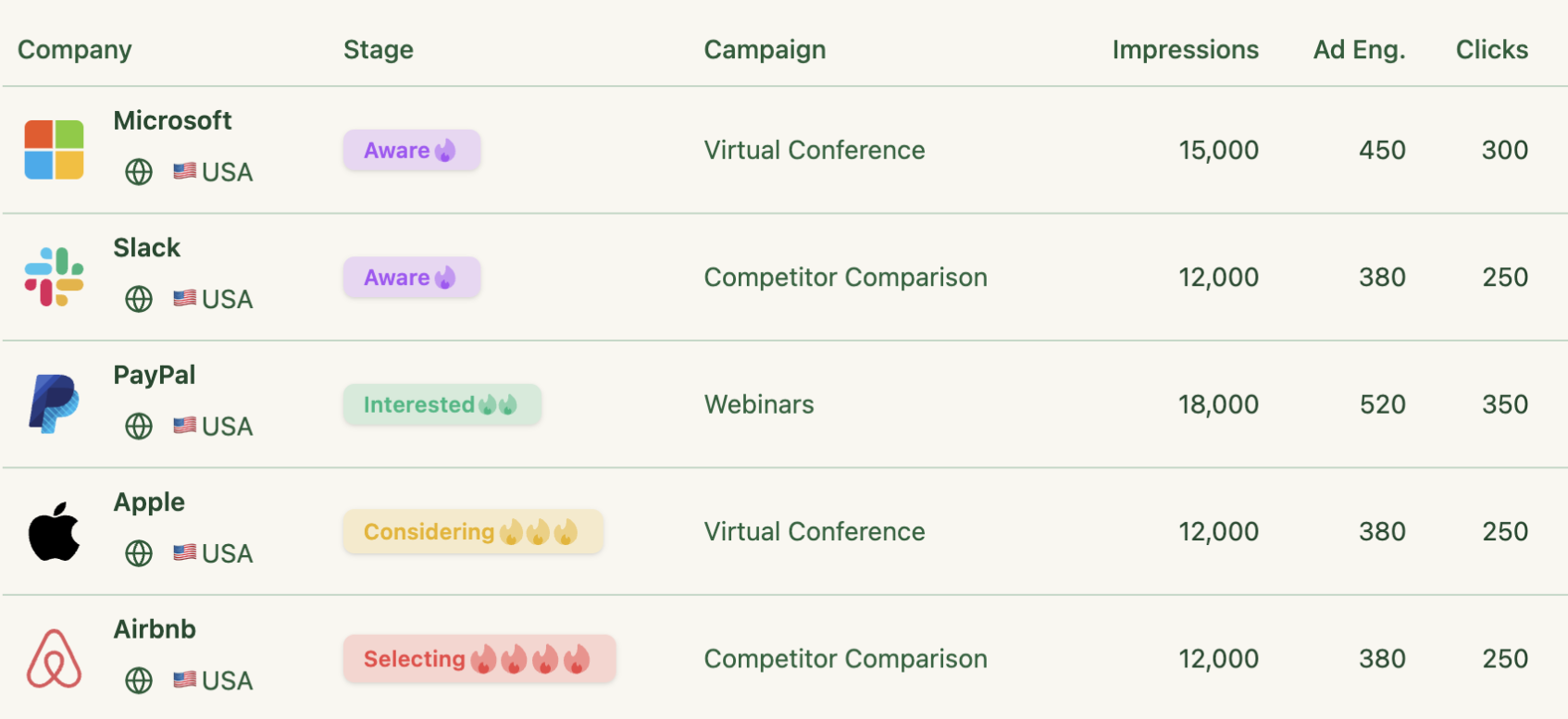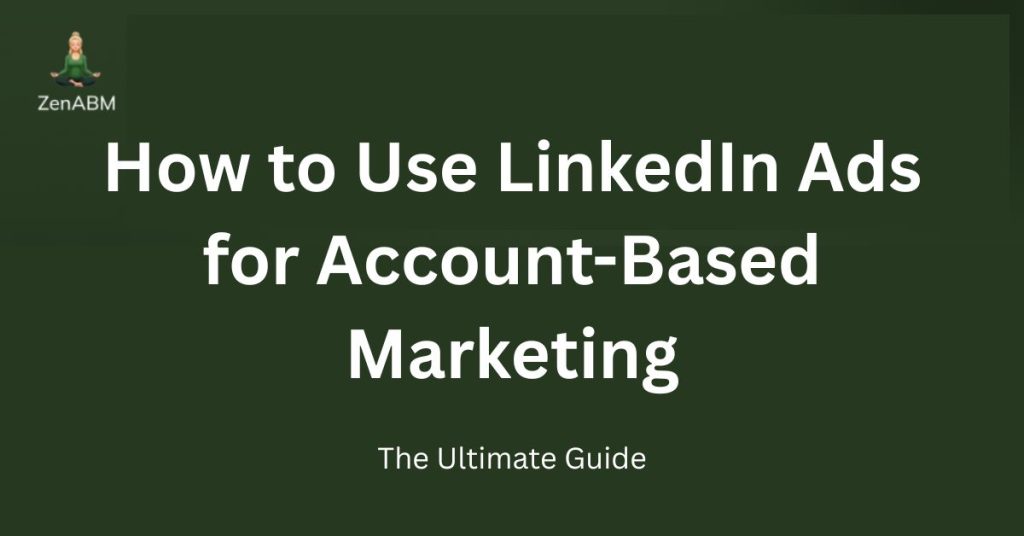In late 2024, our team at Userpilot kicked off our first ABM program ($900,000+ in pipeline and roughly $8 in pipeline per dollar – these numbers are still changing as we are still running ABM). None of us had run ABM before, and our ACV only recently justified it, so we learned fast and in public. If you’re wondering how to use LinkedIn ads for account-based marketing, this walkthrough shows the exact path we took.
For five years, we grew entirely via inbound, mostly organic search. At the 2024 peak, we shipped up to 150 pieces a month and saw 235,000 monthly visitors. Then SEO turbulence hit, updates kept rolling, SERPs jumped around, and traffic drifted back toward baseline.
As the product matured and prices climbed in 2024, our SEO-led conversion rate slid. The channel still worked for lower-ACV sales, less so once deal sizes rose and cycles got longer. In July our CEO flagged a silo problem across marketing. Time to align around one motion and commit to ABM.

The fundamental questions to settle before your first ABM campaign
ABM is unforgiving. Tactics are scarce, playbooks vague, and few teams share specifics like formats, budgets, or ROAS.
Busting Silos by Hillary Carpio
Before you start, answer these:
Goals: What outcomes and KPIs matter per campaign, and which leading indicators (CPM, CTR) will tell you early if you’re on track?
Personalization model: One-to-many, one-to-few, or one-to-one?
Stages and scoring: Which funnel stages will you use, where are the thresholds, and how will you score accounts against them?
Duration: Campaign length and evaluation cadence.
- Channels: Where will you reach accounts with your content?
- Targeting: Which lists and in what order? What’s the ICP and how many personas?
- Content and messaging: What assets and formats will you run, how will you read intent, and when do BDRs engage?
- Budget and resources: Monthly budget, realism vs goals, and the skills required to execute.
- Measurement: Where will performance live and who owns the dashboard?
- Tools: What supports list building, targeting, production, distribution, and project management?
You won’t know every answer on day one. We learned by shipping, measuring, then tightening. Use our notes to skip avoidable mistakes.
ABM goals, setup, personalization level, and duration
We began with one-to-many LinkedIn advertising to surface intent inside our SAM, then graduated warm accounts to more solution and product messaging and eventually BDR outreach.
The key question was timing. When does an account move stages, and what score earns a pass?
We mapped ABM stages to the awareness funnel and leaned on Kyle Poyar’s “GTM metrics 2.0” with ABX benchmarks to set thresholds and goals.
That helped us define:
-
- Stages
-
- Benchmarks for movement between stages
-
- Revenue and budget math using CPM, CTR, CVR, qualification and close rates, and ACV
We structured ABM stages as:
-
- Identified: all targeted accounts
-
- Aware: 50+ impressions
-
- Interested or engaged: 5+ clicks or 10+ engagements
-
- Considering: demo booked or trial
-
- Selecting: open deal
Content shifts by stage:
-
- Identified and awareness: problem and category education
-
- Interested: deeper benefits and use cases
-
- Consideration and selecting: product, proof, and next steps
The first scoring model mixed web visits and weighted events. Execution was overly complex and reverse-IP deanonymization proved unreliable. Even with a no-index ABM microsite, a ~300-visit path yielded only one identified company, our own.
A Syft study showed Clearbit as the most accurate of popular tools, which still wasn’t enough for consistent scoring.
We simplified. We use quantitative LinkedIn ad engagement in the CRM for scoring and treat the qualitative signal of which campaign groups saw engagement as the basis for BDR personalization. This approach lines up cleanly with how to use LinkedIn ads for account-based marketing without overrelying on web deanonymization.
How do we apply the scores to accounts?
Step one was pushing company-level engagement from LinkedIn Campaign Manager to HubSpot. As of January 2025 this isn’t native.
We started with Fibbler, a low-cost LinkedIn API connector for HubSpot. When we needed campaign-level intent, we built our own pipeline with ZenABM so both quantitative and qualitative signals land on company properties.
Campaigns are segmented by intent. We mirror that in HubSpot by assigning matched intents to a multi-checkbox company property using the campaign names from ZenABM. When BDRs create leads, the company’s intents copy down as tags so outreach aligns with what the account engaged with.
Operationally, we push weekly totals into “LinkedIn Ad Engagements – 7 days” and “LinkedIn Ad Clicks – 7 days,” then roll them into cumulative properties from the start of a given ABM campaign.
We then maintain HubSpot Active Lists per stage and per campaign using those cumulative properties.
A workflow updates the “ABM stage” company property off list membership.
ABM goals and budget
After adopting Kyle’s ABX ranges, we set revenue and ACV targets, then worked backward using our win rates.
Example: aiming for $1M at $50k ACV with 25% close and 75% qualification yields 20 deals and a target list near 3367 accounts.
Budget depends on CPMs and conversion costs. If 55% reach awareness, 32% of those show interest, and 18% of interested book demos, you need about 107 demos. With $1100 per conversion your LinkedIn budget is ~$117,700. You can also estimate via CTR and LP CVR. With a 0.4% CTR and 1% LP CVR, you’ll need ~2,675,000 impressions. At a $55 CPM, that’s roughly $147,125. LinkedIn does not spread impressions evenly, so use caps by account with tools like Factors.ai. Add a 15 to 20 percent buffer.
Channels
We started with LinkedIn Ads. We also built a no-follow ABM destination and plan to retarget via Google’s Display network across a curated set of publications plus Gmail and YouTube through Demand Gen. Direct list targeting on Google underperformed due to low match rates.
Account targeting and list building
The first list reused cold outbound targets that met our win-loss filters. We excluded any closed-won accounts.
The second campaign layered technographics to focus a distinct segment. We used Clay and the BuiltWith API.
Selection criteria example for a “Session Replay + Analytics” push:
Firmographic fit
-
- Company size: 50–2,000 employees
-
- Revenue: ideally $5M+ or equivalent funding
-
- Industry: digital-first companies with PLG
-
- Location: US, Canada, ANZ, Ireland, Israel, and Western or Northern Europe
Technographic indicators
-
- Using or used a {use case} competitor
-
- On a direct competitor that lacks {feature}
-
- Redundant stack: {feature1} plus {feature2}
We also mine CRM data for right-fit accounts previously lost due to missing features.
Once a list is ready we add accounts to the HubSpot ABM campaign list, update the “ABM Campaign Name” property, and set the stage to identified.
We prospect PM, UI or UX, PMM, executives, and other relevant personas via Apollo or Clay, enrich for custom fields like Persona and Seniority, then build HubSpot active lists per persona and stage.
These lists sync to LinkedIn Campaign Manager via HubSpot Ad Audiences for dynamic targeting.
Note: You need at least 300 LinkedIn members matched to start. All must be marketing contacts, or they will not sync.
Audiences usually warm up in about 48 hours. After that, layer LinkedIn targeting filters for precision.
All accounts start as “identified.” When an account hits a benchmark like 5+ clicks, we pause awareness for that account, move it to “interested,” and enroll it in the next-stage ads automatically.
Because LinkedIn uses these lists, stage changes flow through to targeting. Messaging stays aligned to where the account is in the funnel and to each persona’s pains and jobs to be done.
Campaign groups map to personas and stages, while campaigns within groups land on specific themes like JTBD, benefits, and proof.
Example: an awareness ad for PMs highlights multiple JTBDs. A consideration ad for PMs shows a case study and the value realized.
Campaign structure and project management
Our first campaign, “Product Drive 2024,” targeted 1417 accounts that didn’t convert during H1 outbound. We split them across 8 personas and built LinkedIn campaigns per persona with tailored JTBD messaging.
Uploading persona lists and pulling company engagement per campaign via ZenABM let us attribute intent and target BDR outreach precisely. We did hit some platform constraints:
- LinkedIn API hides campaign engagements and clicks within a timeframe if fewer than 3 members or events exist for that account
- Campaigns allow one asset type only, so we needed many campaigns
- Later stages sometimes had too few matched members per persona to meet the 300-contact minimum
We pivoted to campaign groups organized by shared intent instead of persona alone, while still excluding irrelevant personas.
This change solved three issues:
-
- Campaign-group attribution aggregates engagements across asset-specific campaigns, increasing the chance of meeting the 3-event API threshold
-
- Asset-specific campaigns still group neatly into meaningful campaign groups
-
- Including several personas per group raises member counts at later stages so separate JTBDs still run
Project management
We used Notion databases to manage asset creation, owners, briefs, and graphic requests. Clean naming was critical because we infer intent from campaign names. Our formula concatenated Persona, Asset type, Asset description, ABM stage, and ABM campaign.
-
- Persona
-
- Asset type: video, image, TLA ad
-
- Asset description: benefit or JTBD for intent
-
- ABM stage
-
- ABM campaign label
We also tracked launch status per asset.
Content and messaging, plus intent
We focused on LinkedIn inventory and mixed formats in this order:
-
- Single image ads
-
- Video ads
-
- Thought Leader Ads
-
- DM ads
-
- Text ads
-
- Document ads
Performance patterns: single image ads drove the highest CTR and lowest CPC to LP, followed by video and TLAs. DM ads were costly per conversion.
Text ads are cheap reach but rarely click. TLA CTRs look strong because clicks include reads, profile taps, and tags. TLAs still help with top-of-funnel attention when backed by ICP-relevant voices. We use them in moderation at the awareness stage.
Our per-campaign inventory split covered benefits, features, JTBDs, webinars, audits, education, case studies, testimonials, and demos.
What messaging worked best?
Here are the top performers from our first ABM run:
Alongside ads, we collaborated with BDRs on email sequences for accounts reaching the “interested” stage.
Resources
We reverse-engineered a budget from revenue targets and stage conversion assumptions. Current burn is about $20k per month. Weekly stage progression serves as a leading indicator for campaign health.
Team setup: ABM manager, Marketing Ops, two designers, a growth or performance manager, and leadership support. You need a strong ops function to make ABM sustainable.
Tools
Most enterprise ABM platforms were pricey and light on proof for our niche, and deanonymization wasn’t reliable enough for scoring. We committed to a stack that fits a LinkedIn-first ABM motion and pushes account engagement into the CRM without heavy data plumbing.
Our current setup:
-
- List building: HubSpot CRM, Clay, BuiltWith
-
- Campaign asset management: Notion
-
- Intent recognition and scoring: ZenABM
-
- Ad ops, lead flow, reporting, outreach: HubSpot marketing
-
- Prospecting: SalesLoft
Total stack cost is about $2500 monthly.
Performance metrics and reporting
Benchmarks are hard to compare across companies. We built our own dashboards in HubSpot and track:
-
- Weekly stage progression per campaign versus benchmark across a 12-week run
- Weekly stage progression per campaign versus benchmark across a 12-week run
-
- Pipeline per dollar as an efficiency metric. Our target for ABM is about $10 per dollar.
-
- Ad performance baselines by format using our history and this reference from the B2B house
- Ad performance baselines by format using our history and this reference from the B2B house
We also watch cumulative stage movement, pipeline by account, and weekly BDR sequencing volume.
Our first ABM campaign
“Product Drive Campaign” targeted multiple personas and their pains, using Product Drive as the gateway asset. We published about 100 ads across 8 personas and spent $46,791 on LinkedIn media.
Our results after 90 days
Accounts touched: 1,417
Total cost: ~$52,191 (LinkedIn spend plus tools)
Pipeline generated: $440k in 3 months. We launched the second campaign two months after the first started.
Pipeline per dollar: $8.43, averaging $12 across both campaigns
Assets: ~100 ads across 8 personas (images, videos, TLAs, DMs, text, docs)
Single-image: 1,172 clicks, 0.35% CTR, $19 CPC
Video: 313 clicks, 0.28% CTR, $24 CPC
TLAs: 4.42% CTR, $68 CPC, inflated by non-visit clicks
Team: 4.5 FTEs across ABM, performance, MOps, leadership, demand gen or PMM, and design
Verdict: does ABM on LinkedIn beat cold outreach?
Cold outbound alone took twice as long and cost 51% more to create similar pipeline. ABM took heavy ops work but matched the setup burden of outbound, produced pipeline faster, and used fewer human-hours by spreading asset creation across the team. In truth we were still harvesting demand, just more efficiently. Running structured LinkedIn programs is a practical answer to how to use LinkedIn ads for account-based marketing at higher ACVs.
Questions welcome. You can reach me on LinkedIn.




